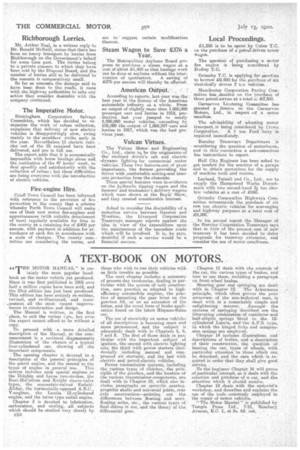A TEXT-BOOK ON MOTORS.
Page 8

If you've noticed an error in this article please click here to report it so we can fix it.
tcrrHE MOTOR MANUAL" is cer
tainly the most pppular handbook on the motor vehicle yet produced. Since it was first published in 1903 over half a million copies have been sold, and the 23rd edition has just been produced. This edition has been entirely re-written, revised, and re-illustrated, and incur • porates all the most recent improvements in construction and design.
The Manual is written, in the first place, to suit the veriest Von, but even the expert cannot afford to be without a copy.
To proceed with a more detailed description of the Manual, at the commencement is a sectional diagaammittia illustration of the chassis of a typical four-cylindered car, showing all the important components.
' The opening chapter is devoted to a description of the general principles of the petrol engine, and the second to the types of engine in general use. This section includes such special engines as the Dolphin and Lucas two-strokes, the Burt-3IcCullurn and Knight sleeve-valve types, the concentric-valved EnfieldAllday, the horizontally-opposed A.B.C., V-engines, the Lancia 12-cylindered engine, and the latest type radial engine.
Chapter 3 is devoted to lubrication, carburation, and cooling, all subjects which should be studied very closely by • C10
those who wish to run their vehicles -with as little trouble as. possible.
The. next chapter includes •a summary of present-day tendencies, dealing in particular with the system of unit construction, aero practice as adapted to highefficiency automobile engines, the praelice of mounting the gear lever on the gearbox lid, or on an extension of the latter, and the novel form of brake application found on the latest Hispano-Suiza ear.
The use of electricity on motor vehicle., of all descriptions is 'becoming snore and more pronounced, and the subject is adequately dealt with in Chapters 5, 6, 7 and 8. The first of these deals in parr ticular with the important subject of ignition, the second with electric lighting sets, the third with power starters (incidentally including manual and compressed air starters), and the last with electric and petrol-electric vehicles.
Power transmission systems, including the various types of clutches, the principles of the gearbox, and the location of the various transmission* components, are dealt with in Chapter 10, which also in; eludes paragraphs on epicyclic gearing, propeller shafts and universal joints, rear axle construction.---pointing out the differences between floating and semifloating axles, etc., the various types of final drives in use, and the theory of the differential gear.
Chapter 11 deals with the controls of the. car, the various types of brakes, and how to use them including a paragraph on front-Wheel brakes,.
Steering gear and springing are dealt with in Chapter 12. TheAckermann principle, which often proves the pone asinorwat of the non-technical man, is dealt with in a remarkably simple and enlightening manner. Amongst the systems of springing described are the interesting combination of cantilever and half-elliptic springs fitted to the 12-cylindered Lancia, and the A.F.S. type, in which the hinged links and compression. springs are employed.
Chapter 14 includes illustrations and descriptions of bodies, and a description of their •construction, the question of heating the car, types of wheals, with particular attention to those which can be detached, and the care which is required in order that they shall give good service.
To the beginner Charstet 16 will prove of particular interest, as it deals with the selection and purchase of a ear, and the attention which it should receive.
Chapter 19 deals with the motorist's workshop, and describes 'and explains the use of the tools commonly employed in the repair of motor vehicles.
"The Motor Manual" is published by Temple Press Ltd., 7-15, Rosebery.
Avenue, E.C. 1, at 3s. 6d. net. •




























